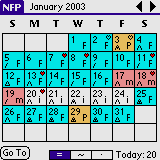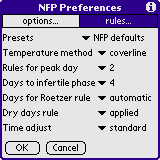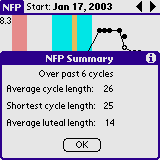![]() Home | Download | Instructions
| FAQ
| Links and Reviews
Home | Download | Instructions
| FAQ
| Links and Reviews
![]()
Instructions for:
Disclaimer: This program is not designed to teach you natural family planning, fertility awareness method or the sympto-thermal method. It assumes that you have learned the details of these methods elsewhere. For additional resources, see Links and Reviews. In addition, the user bears full responsibility, including pregnancy, for the use of this program. The user assumes all risks, including but not limited to programming errors. The user should be competent enough with the methods to confirm the fertility predictions made by the program.
Pill Users: Users on the pill will likely not exhibit the bimodal pattern in their basal body temperature, nor be able to observe changes in vaginal fluid because of the hormonal regulating methods employed by the pill. Additionally, users who have recently stopped using the pill may experience unusually erratic cycles for a number of cycles, making it difficult to use the NFP method until their cycle returns to a normal level of variation.
For additional questions please email me: cbrassil@hotmail.com
 |
The top line will display the date, the day of the current cycle, and the fertility indicator: "m" for menstruating, "i" for infertile, "F" for fertile, and "P" for peak day or ovulation day. If different techniques indicate different peak days, there may be more than one "P" in a cycle. The Palm scroll keys can be used to move forward or backward one day. |
"Temp" is the female's waking basal body temperature in degrees Fahrenheit or Celsius, depending on the user's choice in Preferences. In order to minimize steps, the temperature selector will automatically scroll to include the last selected temperature.
"Time" is the difference in time from when the temperature would normally be taken. For example if you normally take your temperature at 7:00am and you don't take your temperature until 8:00am, you would enter "+1:00". NFP will attempt to compensate for the late temperature in calculations. The time adjusted temperature will be indicated as an open circle on the Cycle Chart view. Time differences greater than or equal to "2:00" will be disregarded in all calculations.
"Sensation" is the vaginal fluid sensation throughout the day. "Heavy Flow" or "Medium Flow" indicate menstruation. The first day of "Heavy Flow" or "Medium Flow" will define the beginning of a cycle. "Dry", "Moist", and "Lubricated" refer to the user's relative sensations through a typical cycle. With increased experience comes increased confidence of your own "Dry", "Moist", and "Lubricated". "Begin Postpartum" is used to begin a chart after pregnancy, before your first menstruation.
"Fluid Color" combines vaginal fluid color and feel. "Shiny" can be safely ignored if it is not a term you use. The terms are in order from top to bottom from least fertile to most fertile. At times you may have to pick a category that is not an exact description. You can use the Note feature for more detailed personal descriptions. If you do not have enough volume to determine a descriptor, just leave the entry as "----".
"Marquette" replaces "Sensation" and "Fluid Color" when chosen as the fluid indicator in preferences. The Marquette rating system combines all fluid indicators into a single scale of increasing fertility from 1 to 8.
"Cervix" combines the cervical position, openness, and feel into one numerical summary. "N" stands for not recorded. "1" indicates low, firm, and closed. While "3" indicates high, soft, and open.
"LHTest" can optionally be used to record luteinizing hormone test results from ovulation test kits. "N" indicates not recorded. "-" indicates a negative test result. "+" indicates a positive test result.
"ClrPlan" replaces "LHTest" when chosen under "Hormone test" under preferences. Clearplan is a commercial test hormone test kit which indicates "L" for low fertility, "H" for high fertility, and "P" for peak fertility. Note that preset "MM II", or Marquette Model II, is designed for users who are using Clearplan as the only indicator of fertility.
"Sex", or "S.I" can be used to record sexual intercourse. "Protected" is for those using other barrier methods during fertile periods.
"Other" is available as a check box for anything the user wishes to record, for example cramps.
"Alcohol" indicates that a large quantity of alcohol was consumed the previous night and the temperature should be ignored. One can use the alcohol checkbox to indicate any other reason that the temperature should be ignored.
"Note" allows the recording of any text message. The full screen of text can be brought up by clicking on the page icon at the end of the line. Text in the "Note" field will be searched by the built-in find feature of Palm OS.
Menu items cannot be accessed from Data Entry view. Return to Month View or Cycle Chart to access menu items and shortcuts.
 |
Click on a day to go to the Data Entry view for that day. Each day displays the day of the month, the predicted fertility indicator, a closed heart for sex or an open heart for protected sex, and data indicator. Collecting all three main pieces of information, temperature, fluid information, and cervix information, will result in all three sides of the triangle being displayed. Collecting less than that will result in either a slash or carat. If additional information was recorded, such as a Note, the Other checkbox, or the Alcohol checkbox, a dot will appear in the center of the triangle. |
Future days may display an "m" indicating a predicted day for the start of a cycle. This guess is based on the last cycle start date and the average cycle length. If ovulation, or a "P", has already been predicted for the current cycle, the projected start date for the next cycle is based on the luteal length.
The Palm scroll keys can be used to move forward or backward one month. Push buttons at the bottom can be used to move between views. Cycle day for today is displayed in the corner.
 |
Cycle Chart will list up to 29 days of the cycle. For longer cycles, clicking on the '>' will scroll forward 7 days. Clicking on a day will take you to the Data Entry View. |
The upper portion of the screen displays the temperatures. The line connects temperatures used in the fertility calculations, including time adjusted temperatures as empty circles. The lower portion displays "FS" for Fluid Sensation, "FC" for Fluid Color, and "Cx" for Cervix. A higher bar in each category indicates a increased fertility for that category. Gray bars in "FS" indicate levels of menstruation flow or spotting. The fertility indicator is indicated along the bottom, with "m" omitted because of space constraints.
The Palm scroll keys can be used to move forward or backward one cycle. Holding the stylus down will display a pop-up window with additional information for that day. Push buttons at the bottom can be used to move between views. Cycle day for today is displayed in the corner.
Menu includes:
"Delete" opens a confirmation box that allows user to delete all records for the current cycle. This can be used to delete cycles greater than 12 cycles old that are no longer used by the program.
"Export" will create a new Memo Pad entry containing a text version of all data on every day of the selected cycle. After syncing with a computer, the memo can be copied and pasted into a spreadsheet like MS Excel. Included in the download is a template file called "NFP.xls". Use this file to generate a printable graph for a paper back-up or to share with your health care provider.
For those who wish to generate there on spreadsheet files the data is in the following format: cycle day; date; fertility indicator; actual temperature; time adjusted temperature if one exists; time adjustment in hours; fluid sensation (1-3 indicates increasing levels of fertility, 0 = no data, -1 = spotting, -2 = medium flow, -3 = heavy flow); fluid color (0 = no data, 1-4 in increasing levels of fertility); cervix (0 = N); LH Test (0 = N); sex (N, Y, or P); other (0 = not checked, 1 = checked); alcohol (0 = not checked, 1 = checked); note (truncated so not to overwhelm Memo Pad). Date is always exported in the format of D/M/Y and temperatures are always exported with periods as the decimal separator.
 |
Preferences allows the user to tailor the way in which the fertility indicators are calculated. The Preferences menu can be accessed from either the Month View or the Cycle Chart View. |
Temperature method: The thermal shift can be calculated using the coverline method in which a line is drawn over six consecutive temperatures. If the next two or three temperatures, depending on the setting for "Days to infertile phase", are above the coverline, the thermal shift is assumed to have occurred. For Celsius, the coverline is drawn through the highest temperature instead of over it, and at least one of the temperatures following the thermal shift need to be 0.2 C higher than the maximum from the first six.
The thermal shift can also be calculated using the average method in which the average of six consecutive temperatures is taken. If the next two or three temperatures are all higher than 0.4 F, or 0.3 C, over the average, then the thermal shift is assumed to have occurred
The "ext cover" (extended coverline) method is similar to the "coverline" method but the coverline includes all temperatures after the first four days. This method is described Clubb & Knight in "Fertility" and on fertilityuk.org. It is designed for those who desire greater certainty with variable cycles.
Rules for peak day is the number of rules that need to be satisfied before one enters the post-ovulatory infertile phase. Rules include: temperature, vaginal fluid, cervical position, and luteinizing hormone test.
Days to infertile phase is the number of days to wait past peak before entering the post-ovulatory infertile phase. Four days is the standard, but experienced users may wish to reduce it to three days.
Days for Roetzer rule is the number of days at the beginning of the cycle to automatically consider infertile. The automatic option includes information about minimum cycle length to choose an appropriate number of days.
Dry days rule extends the infertile phase from the beginning of the cycle as long as the recorded fluid sensation is dry.
Presets chooses among custom, default, three Marquette Model presets, and four Couple to Couple League presets: MM is the standard Marquette Model, MM II is the Marquette Model II based on Clearplan only, and MM Tri-B is the Tri-biological model that uses temperature as well. CCL Rule C, R, B, and A refer to sets of rules developed by the Couple to Couple League. Presets change some of the options and rules as well as other features not listed individually, allowing the Palm program to be customized for use with particular models and methods. For example, the "protected" box is removed from the data entry page for all of the Marquette Model and Couple to Couple League presets in order to conform with the underlying moral and religious philosophies of those methods.
Fluid indicator chooses between the default method of two fluid descriptors, a single scale known as the Marquette Method, or lists which use terminology close to that used by the Couple to Couple League.
Hormone test chooses between a luteinizing test, which is a standard fertility stick, and Clearplan, a high-end commercial test kit.
Time adjust changes the way in which late or early temperature recordings are adjusted. When set to standard, temperatures are changed by 0.1 degree F for each half hour. When set to half rate, temperatures are chagned by 0.1 degree F for each hour.
 |
The summary statistics can be accessed through the menu from either the Month View or the Cycle Chart View.
Summary statistics are calculated over at most 12 cycles. These values are used to adjust the automatic Roetzer rule (see preferences) as well as to project future cycle start days. |
Luteal length refers to the time period between the ovulation and the start of the next cycle. Even in women with variable cycle lengths, the luteal length is very consistent.
 |
The Alarm feature can be accessed through the menu from either the Month View or the Cycle Chart View. The Alarm feature demonstrates why Palms are uniquely suited as a tool for NFP. They are a convenient method of recording the information, but a Palm can also remind you to record your information. |
The morning alarm will not be activated if the temperature for that day has already been entered.
The evening alarm will not be activated if fluid sensation, fluid color, or cervical position have already been entered for that day.
Disabling alarms after peak will turn off all alarms once ovulation has been identified, and reactivate them when the next cycle begins.
 |
The Password feature can be accessed through the menu from either the Month View or the Cycle Chart View. A password will be requested whenever the program is started. Password protection is only designed to prevent someone from accidentally opening your NFP program. A determined person who understands the workings of a palm could easily gain access to your NFP data with the aid of a computer. |